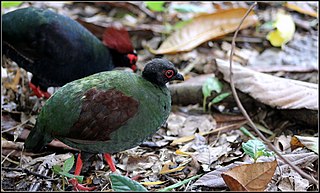
A partridge is a medium-sized galliform bird in any of several genera, with a wide native distribution throughout parts of Europe, Asia and Africa. Several species have been introduced to the Americas. They are sometimes grouped in the Perdicinae subfamily of the Phasianidae. However, molecular research suggests that partridges are not a distinct taxon within the family Phasianidae, but that some species are closer to the pheasants, while others are closer to the junglefowl.

The Phasianidae are a family of heavy, ground-living birds, which includes pheasants, partridges, junglefowl, chickens, turkeys, Old World quail, and peafowl. The family includes many of the most popular gamebirds. The family includes 185 species divided into 54 genera. It was formerly broken up into two subfamilies, the Phasianinae and the Perdicinae. However, this treatment is now known to be paraphyletic and polyphyletic, respectively, and more recent evidence supports breaking it up into two subfamilies: Rollulinae and Phasianinae, with the latter containing multiple tribes within two clades. The New World quail (Odontophoridae) and guineafowl (Numididae) were formerly sometimes included in this family, but are now typically placed in families of their own; conversely, grouse and turkeys, formerly often treated as distinct families, are now known to be deeply nested within Phasianidae, so they are now included in the present family.

Francolins are birds in the tribe Gallini that traditionally have been placed in the genus Francolinus, but now commonly are divided into multiple genera.

The grey partridge, also known as the grey-legged partridge, English partridge, Hungarian partridge, or hun, is a gamebird in the pheasant family Phasianidae of the order Galliformes, gallinaceous birds. The scientific name is the Latin for "partridge", and is itself derived from Ancient Greek perdix.
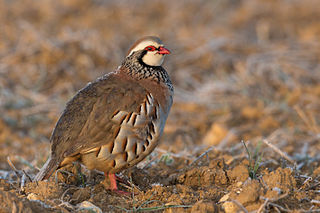
The red-legged partridge is a gamebird in the pheasant family Phasianidae of the order Galliformes, gallinaceous birds. It is sometimes known as French partridge, to distinguish it from the English or grey partridge. The genus name is from Ancient Greek alektoris a farmyard chicken, and rufa is Latin for red or rufous.
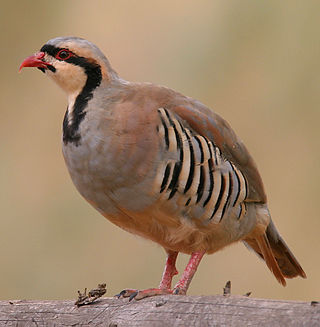
The chukar partridge, or simply chukar, is a Palearctic upland gamebird in the pheasant family Phasianidae. It has been considered to form a superspecies complex along with the rock partridge, Philby's partridge and Przevalski's partridge and treated in the past as conspecific particularly with the first. This partridge has well-marked black and white bars on the flanks and a black band running from the forehead across the eye down the head to form a necklace that encloses a white throat. Native to Asia, the species has been introduced into many other places and feral populations have established themselves in parts of North America and New Zealand. This bird can be found in parts of Middle East and temperate Asia.

The rock partridge or common rock partridge is a gamebird in the pheasant family, Phasianidae, of the order Galliformes. It is native to southern Europe, and is closely related and very similar to its eastern equivalent, the chukar partridge, A. chukar.

The Barbary partridge is a gamebird in the pheasant family (Phasianidae) of the order Galliformes. It is native to North Africa.

Coturnix is a genus of five extant species and five to eight known extinct species of Old World quail.

Perdix is a genus of Galliform gamebirds known collectively as the 'true partridges'. These birds are unrelated to the subtropical species that have been named after the partridge due to similar size and morphology.
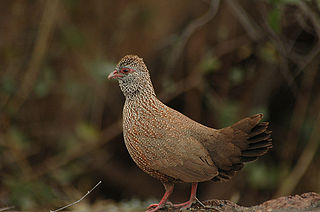
The stone partridge is a bird of the New World quail family. This largely brown bird, which commonly holds its tail raised, is found in scrubland and lightly wooded habitats, often near rocks, from Kenya and Ethiopia to Gambia.

The grey francolin is a species of francolin found in the plains and drier parts of the Indian subcontinent and Iran. This species was formerly also called the grey partridge, not to be confused with the European grey partridge. They are mainly ground-living birds and are found in open cultivated lands as well as scrub forest and their local name of teetar is based on their calls, a loud and repeated Ka-tee-tar...tee-tar which is produced by one or more birds. The term teetar can also refer to other partridges and quails. During the breeding season calling males attract challengers, and decoys were used to trap these birds especially for fighting.

Philby's partridge or Philby's rock partridge, is a relative of the chukar, red-legged partridge and barbary partridges and is native to southwestern Saudi Arabia and northern Yemen. Although similar in appearance to other Alectoris species, Philby's partridge can be distinguished by its black cheeks and throat. Although not currently listed as an endangered species, the Arab Spring and destruction of its fragile habitat in the tribal areas of Northern Yemen had led to concerns about the survival of this species. The name commemorates the British explorer St John Philby.

The Arabian partridge is a species of bird in the family Phasianidae, native to the southern Arabian peninsula. Two subspecies are recognised, A. m. melanocephala and A. m. guichardi. It sometimes hybridises with Philby's partridge and with the rock partridge.

The Taiwan partridge or Taiwan hill partridge is a species of bird in the family Phasianidae. It is found only in Taiwan, and its natural habitat is broadleaf forests. It is threatened by habitat loss, but at present is categorised by the International Union for Conservation of Nature (IUCN) as being of least concern.
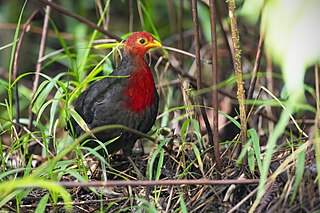
The crimson-headed partridge is a species of bird in the pheasant, partridge, and francolin family Phasianidae. Described by the British ornithologist Richard Bowdler Sharpe in 1879, it is the only species in the genus Haematortyx. It is endemic to Borneo, where it inhabits lower montane forest in the northern and central parts of the island. It is mainly found at elevations of 1,000–1,700 m (3,300–5,600 ft), but can be seen as low as 185 m (607 ft) and as high as 3,050 m (10,010 ft). Adult males have a striking appearance, with a dark blackish body and crimson red heads, necks, breasts, and undertail coverts. Females have a similar pattern, but with duller brownish-black colouration, orangish-red heads and breasts, and a brownish-black bill instead of a yellowish one. Juveniles are duller and have the crimson restricted to the top of the head.
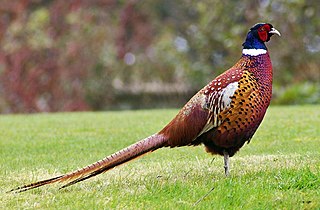
The Phasianinae are a subfamily of the pheasant family (Phasianidae) of landfowl, the order Galliformes. The subfamily includes true pheasants, tragopans, grouse, turkey and similar birds. Although this subfamily was considered monophyletic and separated from the partridges, francolins, and Old World quails (Perdicinae) till the early 1990s, molecular phylogenies have shown that this placement is paraphyletic. For example, some partridges (genus Perdix) are more closely affiliated to pheasants, whereas Old World quails and partridges from the genus Alectoris are closer to junglefowls. There are two clades in the Phasianinae: the erectile clade and the non-erectile clade, referring to erectile tissue in the non-feathered parts of the face. Both clades are believed to have diverged during the early Oligocene, about 30 million years ago.

Perdicinae is a polyphyletic former subfamily of birds in the pheasant family, Phasianidae, regrouping the partridges, Old World quails, and francolins. Although this subfamily was considered monophyletic and separated from the pheasants, tragopans, junglefowls, and peafowls (Phasianinae) till the early 1990s, molecular phylogenies have shown that these two subfamilies actually constitute only one lineage. For example, some partridges are more closely affiliated to pheasants, whereas Old World quails and partridges from the Alectoris genus are closer to junglefowls. Due to this, the subfamily Perdicinae is no longer recognized by the International Ornithological Congress, with the species being split among 3 subfamilies.

Pternistis is a genus of galliform birds formerly classified in the spurfowl group of the partridge subfamily of the pheasant family. They are described as "partridge-francolins" in literature establishing their phylogenetic placement outside the monophyletic assemblage of true spurfowls. All species are endemic to Sub-Saharan Africa, excepted the double-spurred spurfowl. They are commonly known as spurfowls or francolins, but are closely related to jungle bush quail, Alectoris rock partridges, and Coturnix quail. The species are strictly monogamous, remaining mated indefinitely. They procure most of their food by digging. Spurfowls subsist almost entirely on roots, beans of leguminous shrubs and trees, tubers, and seeds, and feasting opportunistically on termites, ants, locusts, flowers, and fruit. Important predators are jackals, caracals, servals, and birds of prey, as well as herons and marabou storks.




























